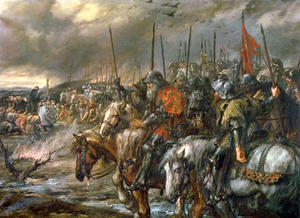Battle of White Mountain
|
The Battle of White Mountain (Dwarven: Krazdran eron Haj'Nogaak), was an early battle in the Eighteen Years' War fought on the 12th of the Sun's Smile, 1536, in which an army of 19,000 dwarves and human mercenaries under Belegar Ireheart were defeated by 20,000 men and elven auxiliaries of John I, Holy Orenian Emperor, led by the general Henry Rothesay, at Haj'Nogaak ("White Mountain"), near Erochland. The battle marked the beginning of the Orenian invasion of the Grand Kingdom of Urguan, leaving the Orenian landing point of Erochland and Luciensport safeguarded from Dwarven incursion.
Prelude
In the early stages of the Eighteen Years' War, the Grand Kingdom of Urguan, with a hired assortment of Dunamis mercenaries and otherwise, committed to a raiding policy, harassing numerous border settlements (including the ports of Erochland and Luciensport) and pirating human trade vessels from Orenian enclaves. The Orenian capital of Felsen would be effectively blockaded economically, failing to receive the important ores, salt, and exotic lumber which Erochland provided. The dwarves also frequently pillaged and destroyed human hamlets and villages during their incursions, causing massive outrage with the Imperial Estates. On the urging of his councilor, Henry Rothesay, Emperor John amassed a fleet and force within Dogger Bay (later joined by elven reinforcement at the port of Erochland itself).
Through its network, Urguan soon found out of the approaching force ordered a host be made under leadership of the dwarven general Belegar Ireheart. However, unwilling to cease the pillaging policy, a sizable force of Urguanites remained east and south upon the Upper Eroch.
Battle
In 1536, by now fully established as Emperor, John I set out to conquer the Urguanite coast and make an example of the raiders. Grand King Rhewen and his military commander, Belegar Ireheart, had organized a dwarven army of 25,000 soldiers total; John countered with an initial force of 20,000, many of them seasoned soldiers of the Dukes' War, under the capable leadership of Field Marshal Rothesay, his distant cousin and a brother of the Archchancellor Adrian Rothesay. Rothesay's army enjoyed the advantage of including two of the most successful military leaders in Orenian history - Rothesay himself and the future general Josef Vladov. Rothesay's force was made up of two distinct groups: Imperial troops commanded by Rothesay himself, and soldiers of the elven vassal states, under the command of Prince Artemic Camoryn. All of the armies of the day employed numerous mercenaries, including the ruthless commander Richard Revlis, who personally led multiple attacks upon Oren throughout the years.
After subduing most of the dwarven parties in southern Erochland, the Imperial army made for Rhewengrad, the Urguanite fortress protecting the capital, then in dwarven hands. The Urguanites attempted to block them by setting up defensive positions, which the Imperial army simply bypassed. Force-marching his men, Belegar Ireheart managed to get ahead of the Imperial army just before Rhewengrad. He thus gained an advantageous position on the "White Mountain", actually a low plateau, but had little time to set up defensive works. Enthusiasm for joining battle was high on both sides, eager to give each party a crushing blow. After the reverses of the previous several weeks and the central Urguanite government demanding more forces in defense of the important dwarven holds throughout the Shattered Sea, the army had been reduced to about 19,000 men.
On the 1st of the First Seed, a small Imperial force was sent to probe the dwarven flank. To their surprise, the dwarves retreated at their advance. Rothesay quickly sent in reinforcements, and the dwarven flank began to crumble. Belegar tried to retrieve the situation by sending forward infantry and cavalry led by Richard Revlis. The cavalry charged into the Imperial infantry, causing significant casualties, but Rothesay countered with his own cavalry, forcing the Dunamis horsemen to retire. The dwarven infantry, who were only now approaching the Imperial army, saw the cavalry retreating, at which they fired one volley at extreme range before retreating themselves. A small group of Imperial cavalry began circling the Urguanite forces, driving them to the middle of the battlefield. With the dwarven army already demoralized, company after company began retreating, most without having actually entered the battle. Rothesay and the Imperial Army made quick work of the stragglers, with majority of the forces retreating westward towards Rhewengrad.
Aftermath and Legacy
With the dwarven army routed, Rothesay began preparations for a siege against Rhewengrad in the next year, being reinforced by a multitude of eager recruits and zealous noblemen. The battle effectively damaged the dwarven raiding policy, leaving Erochland and Luciensport effectively protected from future molestation. Belegar Ireheart reunited his routed army within Rhewengrad, attempting to create a defensive position against the Imperial Army. However, conflicting orders between the Urguanite government led to an ineffective fortification effort.
Before the war, nearly 20,000 humans lived within Erochland and its outlying regions, while by the year 1547 only around 500 remained.
